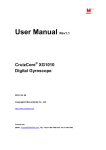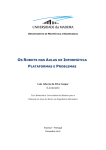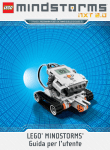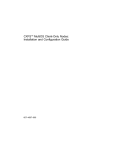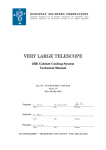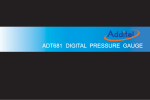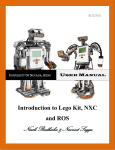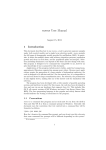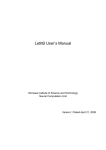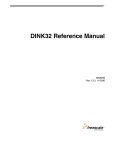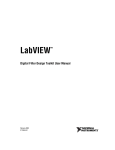Download The Cruizcore XG1300L
Transcript
CruizCore® XG1300L USER’S MANUAL ® The Cruizcore XG1300L Digital Gyroscope and Accelerometer for the LEGO® MINDSTORMS® NXT User’s Manual Rev1.1 2013. 05. 20 Copyright© Microinfinity Co., Ltd. http://www.minfinity.com EMAIL: [email protected], TEL: +82 31 546 7408 FAX: +82 31 546 7409 Note: This product is not connected to or endorsed by The LEGO Group. LEGO MINDSTORMS are trademarks of The LEGO Group. Microinfinity reserves all rights in this document and its subject matter. The recipient acknowledges these rights and assures the use of this document only for the purpose it was delivered. 1 CruizCore® XG1300L USER’S MANUAL 1. Introduction to Inertial Sensors Inertial sensors are self-contained devices that can measure rates of rotation (gyroscopes) and linear motion (accelerometers). These devices do not require external signals or references in order to operate. 1.1 Gyroscopes A gyroscope (or gyro) is a sensor that can measure rate of rotation about a specific axis. The output of these devices can be added up (integrated) over time in order to estimate the angle of rotation. Most common applications use gyros as angle measurement devices. For example, a robot turning at 30 deg/sec (degrees per second), can make a 180 deg turn in 6 seconds (TIME). If a gyroscope is attached to the robot, at any given time its output will be 30 deg/sec. Suppose that the gyro updates its output 100 times per second (FREQUENCY), the number of samples (N) that the gyro will output during the 6 second rotation will be: N = TIME*FREQUENCY = 6*100 = 600 The sampling period (PERIOD) is computed as the inverse of the frequency: PERIOD = 1/FREQUENCY = 0.01 [seconds] And the heading angle can be computed by integrating the individual gyro readings as follows: ANGLE = RATE[0]*PERIOD + RATE[1]*PERIOD + … + RATE[N]*PERIOD ANGLE = 30*0.01 + 30*0.01 + … + 30*0.01 = 180 [degrees] In the practice, gyros are affected by several factors such as bias drift, temperature and acceleration. Suppose now that in our previous example, the contributions of these sources of error make the gyro output 1% larger than the true rate value, in this case, the estimated angle at the end of the turn will have an error of about 2 degrees: ANGLE = 30.3*0.01 + 30.3*0.01 + … + 30.3*0.01 = 181.8 [degrees] Some errors such as drift will affect the gyro output even if the robot is stationary, and if not taken in consideration, can create significant errors over time. In mobile robotic applications gyros are commonly used to determine the robot orientation (or heading), furthermore, the gyro output can be combined with wheel encoder data in order to estimate the robot position. 1.2 Accelerometers An accelerometer is a sensor that can measure velocity changes (acceleration) as well as the gravity acceleration. In theory, after removing the gravity acceleration component, the output of these sensors could be integrated once to estimate velocity and a second time to estimate position. In the practice this sensors are also affected by errors and the double integration needed for estimating position produces unpredictable results within seconds of operation. The most common use of these sensors is to measure the gravity acceleration component, which in Microinfinity reserves all rights in this document and its subject matter. The recipient acknowledges these rights and assures the use of this document only for the purpose it was delivered. 2 CruizCore® XG1300L USER’S MANUAL turn is directly related to the tilt angle of the sensor. A pair of accelerometers mounted on a robot with the X-axis (ACC_X) pointing towards the side and the Y-axis pointing forward (ACC_Y), can be used to compute tilt angles (ROLL and PITCH) as follows: sin(PITCH) = ACC_Y / GRAVITY sin(ROLL) = ACC_X / (GRAVITY*cos(PITCH)) This solution assumes that the measurements are taken when the robot is either stationary or moving at constant speed. For small angles the equations can be further simplified as follows: PITCH = ACC_Y / GRAVITY [radians] ROLL = ACC_X / GRAVITY [radians] Another application for accelerometers is as a robot collision detector. A robot hitting an obstacle will experience large changes in velocity (accelerations) for very short periods of time. These large accelerations can be used as an indication that the robot hit an obstacle. 2. The CruizCore® XG1300L The CruizCore® XG1300L is a digital device containing MEMS gyroscope and accelerometer ® ® ® sensors. This device is compatible with the Lego Mindstorms NXT kit. The CruizCore XG1300L internally processes the sensor signals eliminating the most significant errors that affect these type of inertial devices. The sensor outputs from the CruizCore® XG1300L are near-free of errors and can be used without further processing in many types of applications. 2.1 Sensor Description The CruizCore® XG1300L contains a single axis MEMS gyroscope. The internal signal processing applies factory calibrated scale factors, and compensates for the most significant errors that affect gyroscopes such as changes in bias drift. The CruizCore® XG1300L internally computes the accumulated angle and makes it available to the user as an additional measurement. Users interested in measuring angles are encouraged to use this measurement because of the following reasons: 1. Applications with limited computational resources will not need to integrate the rate measurements in order to obtain angle information. Furthermore, some applications can choose a lower update rate of the angle value and still get the maximum accuracy since the integration is always performed at the maximum update rate (100 Hz). For example, for position estimation in low dynamic robotic applications, users can use an angle update rate of 10 Hz without loosing accuracy. 2. The internal angle estimation is the most accurate, because the XG1300L computes it using full floating point precision. The XG1300L also includes a three-axis accelerometer. This device can be configured to use one of the following ranges ±2G, ±4G and ±8G. As in the case of the gyroscopes, these sensors are factory calibrated. 2.2 Communication Interface Microinfinity reserves all rights in this document and its subject matter. The recipient acknowledges these rights and assures the use of this document only for the purpose it was delivered. 3 CruizCore® XG1300L USER’S MANUAL The CruizCore® XG1300L communicates with the Lego ® Mindstorms® NXT using the I2C bus. It ® ® includes a connector compatible with Lego NXT cables. The CruizCore XG1300L I2C address is set to 0x02. Sensor data is stored internally in different registers that the NXT can access by sending read commands to the appropriate registers (see Table 1). In addition to the register read operations, the CruizCore® XG1300L provides some additional functions that can be accessed by sending write commands to specific registers as shown in Table ® Table 1: The CruizCore XG1300L internal registers REGISTER (Hex value) Sensor Value 0x42 Accumulated Angle LSB 0x43 Accumulated Angle MSB 0x44 Rate of Turn LSB 0x45 Rate of Turn MSB 0x46 X-Accelerometer LSB 0x47 X-Accelerometer MSB 0x48 Y-Accelerometer LSB 0x49 Y-Accelerometer MSB 0x4A Z-Accelerometer LSB 0x4B Z-Accelerometer MSB 2. These functions allow resetting the sensor as well as changing the accelerometers scale factor. Table 2: The CruizCore® XG1300L special function registers REGISTER (Hex value) XG1300L ACTION 0x60 Reset device 0x61 Select ±2G accelerometer range 0x62 Select ±4G accelerometer range 0x63 Select ±8G accelerometer range Microinfinity reserves all rights in this document and its subject matter. The recipient acknowledges these rights and assures the use of this document only for the purpose it was delivered. 4 CruizCore® XG1300L USER’S MANUAL 2.3 I2C Communication Speed ® The CruizCore XG1300L has been tested to work reliably using the low speed I2C setting at 9.6 Kbps. Internally the sensor updates the measurement 100 at 100 Hz. 2.4 Scale Factor ® The inertial sensors in the CruizCore XG1300L are factory calibrated and the measurements provided in the form of signed short integers (16 bits or two bytes). The two bytes represent the sensor reading multiplied by a scale factor of 100. The angle and rate outputs can be estimated using the following equations: ANGLE = (MSB*256 + LSB) / 100 [degrees] RATE = (MSB*256 + LSB) / 100 [degrees/second] For example a two-byte reading from the register 0x42 (LSB and MSB angle bytes) that gives the byte sequence 0x1D and 0x32, should be interpreted as: LSB = 0x1D (hexadecimal) = 29 (decimal) MSB = 0x32 (hexadecimal) = 50 (decimal) ANGLE = (MSB*256 + LSB) / 100 = (50*256 + 29) / 100 = 128.29 [degrees] The accelerometer output takes in consideration the accelerometer range (ACC_RANGE) and is computed as follows: ACCELERATION = (MSB*256 + LSB) /1000 * ACC_RANGE / 2 [g] The ACC_RANGE value can be: 2, 4 or 8; corresponding to +/-2G, +/-4G or +/-8G accelerometer ranges. For example a two-byte reading from the register 0x46 (LSB and MSB X-accelerometer bytes), with a scale factor set to +/-4G (ACC_RANGE=4) that gives the byte sequence 0x8F and 0x01, should be interpreted as: LSB = 0x8F (hexadecimal) = 143 (decimal) MSB = 0x01 (hexadecimal) = 1 (decimal) ACCELERATION = (MSB*256 + LSB) / 1000 *ACC_RANGE / 2= (1*256 + 143) / 1000 * 4 / 2 = 0.798 [g] 2.5 Static Bias Drift Static bias drift affects all gyros and is defined as a non-zero output that can be observed when a ® gyro is stationary. The CruizCore XG1300L estimates this value during startup, this process takes approximately one second in which the sensor must remain stationary. Failing to observe this recommendation will produce unreliable results, which are shown as a constant drift on the angle value when the unit is stationary. Since in many cases the XG1300L sensor will be mechanically attached to the NXT controller, it is likely that when the power button is pressed the XG1300L will Microinfinity reserves all rights in this document and its subject matter. The recipient acknowledges these rights and assures the use of this document only for the purpose it was delivered. 5 CruizCore® XG1300L USER’S MANUAL also move causing it to miscalculate the bias drift value. This effect can be reversed by sending a reset command to the device as explained in the following section (Device Reset Function section). 2.6 Device Reset Function During reset, the XG1300L will recomputed the bias drift value, therefore is must remain stationary. The bias drift value will change randomly over time due to temperature variations, however the internal algorithm in the XG1300L will compensate for these changes. We strongly recommend issuing a reset command to the XG1300L at the beginning of the program. The reset function also resets the accumulate angle value to a zero. Since the accelerometers measurements are taken with respect to the sensor reference frame (see Sensor Reference Axes section) the reset function will have no effect in the accelerometer measurements. 2.7 Sensor Reference Axes The gyroscope sensitive axis is perpendicular to the flatter area of the sensor and pointing down. The accelerometer X-axis is pointing towards the side of the device, the Y-axis points forward and away from the sensor connector, and the Z-axis points down as shown in Figure 1. Figure 1: The CruizCore XGL1300L sensor reference frame 2.8 Programming Tools and Environments ® The CruizCore XG1300L implements a communication protocol compatible with Lego® NXT, Microinfinity reserves all rights in this document and its subject matter. The recipient acknowledges these rights and assures the use of this document only for the purpose it was delivered. 6 CruizCore® XG1300L USER’S MANUAL therefore giving users freedom to work with their favorite programming tools. The CruizCore® XG1300L has been verified to work reliably with the following programming tools and environments: - NXT-G and nxtOsek Source code and examples for these two environments can be found in our web site at: http://www.minfinity.com/eng/page.php?Main=1&sub=1&tab=5 - NXC Source code and examples can be found in our web site at: http://www.minfinity.com/eng/page.php?Main=1&sub=1&tab=5 ® The next release of BricxCC and NCB/NXC will provide native support to the CruizCore XG1300L (thanks to John Hansen). Users may use the test release built from: http://bricxcc.sourceforge.net/test_releases/ - RobotC Support for RobotC has ben added by Xander Soldaat and can be found at: http://botbench.com/driversuite - Lejos Support for this environment has been contributed by Daniele Benedettelli and is available starting with LejOS 0.9.x at http://lejos.sourceforge.net/ 2.9 Source Code Example The following program shows all the functions available in the CruizCore®XG1300L. For explanation purposes we chose the NXC programming language. The program reads and displays the complete device data packet. Users can reset the device by pressing the left button or change the accelerometers scale factor by pressing the right button. The angle and rate measurements are presented in units of hundredths of degrees and hundredths of degrees/second, while the acceleration measurements are presented in thousands of gravities or mg. //Define constants #define XGL_PORT S1 #define XGL_ADDR 0x02 #define XGL_DATA_REG 0x42 #define XGL_RESET_REG 0x60 #define XGL_ACC_SF_REG 0x61 #define XGL_DATA_PACKET 10 #define XGL_COMMAND 2 #define XGL_TIME_OUT 500 //Current accelerometer range value byte ACC_RANGE=2; Microinfinity reserves all rights in this document and its subject matter. The recipient acknowledges these rights and assures the use of this document only for the purpose it was delivered. 7 CruizCore® XG1300L USER’S MANUAL //XGL1300L sensor data packet struct XGLpacket { short mAng; short mRate; short mAccX; short mAccY; short mAccZ; }; //Reset XGL1300L sensor void XglReset() { byte cmd[XGL_COMMAND]; byte n_read=0; ArrayBuild(cmd,XGL_ADDR, XGL_RESET_REG); while (I2CStatus(XGL_PORT, n_read) == STAT_COMM_PENDING); I2CWrite(XGL_PORT,0,cmd); ACC_RANGE=2; } //Change scale factor to +/- 2G, 4G or 8g void XglAccSF() { byte cmd[XGL_COMMAND]; byte n_read=0; ACC_RANGE=(ACC_RANGE==8)?2:ACC_RANGE<<1; byte register= XGL_ACC_SF_REG+((ACC_RANGE/2)>>1); ArrayBuild(cmd,XGL_ADDR, register); while (I2CStatus(XGL_PORT, n_read) == STAT_COMM_PENDING); I2CWrite(XGL_PORT,0,cmd); } //Reads the full packet from XGL1300L void XglReadPacket(XGLpacket &XglData) { byte data[XGL_DATA_PACKET]; byte cmd[XGL_COMMAND]; byte count=XGL_DATA_PACKET; byte n_read=0; ArrayBuild(cmd,XGL_ADDR, XGL_DATA_REG); while (I2CStatus(XGL_PORT, n_read) == STAT_COMM_PENDING); if (I2CBytes(XGL_PORT, cmd, count, data)) {//Assemble data XglData.mAng = data[0] + data[1]*256; XglData.mRate = data[2] + data[3]*256; XglData.mAccX = (data[4] + data[5]*256)*ACC_RANGE/2; XglData.mAccY = (data[6] + data[7]*256)*ACC_RANGE/2; XglData.mAccZ = (data[8] + data[9]*256)*ACC_RANGE/2; } } Microinfinity reserves all rights in this document and its subject matter. The recipient acknowledges these rights and assures the use of this document only for the purpose it was delivered. 8 CruizCore® XG1300L USER’S MANUAL task main() { XGLpacket xgl; string msg; ReadButtonType rbArgs; //Initialize system SetSensorLowspeed(XGL_PORT); //Resets sensor and waits for hardware to settle XglReset(); Wait(XGL_TIME_OUT); //Main loop while (1) { ClearScreen(); XglReadPacket(xgl); TextOut(0, LCD_LINE1,"<<RESET SENSOR", false); //Print sensor data TextOut(0, LCD_LINE2,"ANGLE:"); NumOut(40, LCD_LINE2,xgl.mAng); TextOut(0, LCD_LINE3,"RATE:"); NumOut(40, LCD_LINE3,xgl.mRate); TextOut(0, LCD_LINE5,">>ACC RANGE +/-"); NumOut(92, LCD_LINE5,ACC_RANGE); TextOut(0, LCD_LINE6,"ACC_X:"); NumOut(40, LCD_LINE6,xgl.mAccX); TextOut(0, LCD_LINE7,"ACC_Y:"); NumOut(40, LCD_LINE7,xgl.mAccY); TextOut(0, LCD_LINE8,"ACC_Z:"); NumOut(40, LCD_LINE8,xgl.mAccZ); //Reset sensor if user presses the left key rbArgs.Index = BTNLEFT; SysReadButton(rbArgs); if (rbArgs.Pressed) { XglReset(); TextOut(0, LCD_LINE1,"Resetting Device Wait(XGL_TIME_OUT); } ", false); //Change accelerometer range if user presses the right key rbArgs.Index = BTNRIGHT; SysReadButton(rbArgs); if (rbArgs.Pressed) { XglAccSF(); TextOut(0, LCD_LINE5,"Changing Range ",false); Wait(XGL_TIME_OUT); } Wait(100); } } Microinfinity reserves all rights in this document and its subject matter. The recipient acknowledges these rights and assures the use of this document only for the purpose it was delivered. 9 CruizCore® XG1300L USER’S MANUAL 2.10 Technical Specification Performance Gyroscope Input Dynamic Range ± 100 ˚/sec (Continuous) ± 150 ˚/sec (Instantaneous) Rate Noise (1σ @ 50Hz bandwidth) < 0.1 ˚/sec Scale Factor Error 0.5 % (Typical) Sensitivity 0.01 ˚/sec/digit (Rate) 0.01 ˚/digit (Accumulated angle) Accelerometers Bandwidth 50 Hz Bias Drift 10 ˚/hr (Typical) Measurement Range ±2G, ±4G, ±8G(Selectable) Sensitivity 1 mg/digit (Typical, ±2G setting) 2 mg/digit (Typical, ±4G setting) 3.9 mg/digit (Typical, ±8G setting) Physical Electrical Environmental Output Update Rate 100Hz Weight < 15 grams Size 48 mm X 32 mm X 21 mm Power Consumption < 60mW (@5V) Input Voltage 3.3 ~ 5.5 V Operating Temperature -20 ~ 80 °C Storage Temperature -40 ~ 100 °C Shock 200 gRMS Microinfinity reserves all rights in this document and its subject matter. The recipient acknowledges these rights and assures the use of this document only for the purpose it was delivered. 10 CruizCore® XG1300L USER’S MANUAL Contact Information Corporate Office Microinfinity Co., Ltd. 8F KANC, 906-10, Iui-dong, Yeongtong-gu, Suwon-si Gyeonggi-do, 443-270, Korea Tel : +82 31 546 7408 Fax : +82 31 546 7409 Email: [email protected] USA Technical Support P.O. Box 131284 Ann Arbor, MI 48105, USA Tel : +1-734-223-5904 Fax : +1-866-400-3125 Email: [email protected] Homepage: http://www.minfinity.com Microinfinity reserves all rights in this document and its subject matter. The recipient acknowledges these rights and assures the use of this document only for the purpose it was delivered. 11 CruizCore® XG1300L USER’S MANUAL CUSTOMER RESPONSE It is our intention to provide you with the best documentation possible to ensure successful use of your Microinfinity product. If you wish to provide your comments on organization, clarity, subject matter, and ways in which our documentation can better serve you, please FAX your comments. Please list the following information, and use this outline to provide us with your comments about this manual and product. 1. What are the best features of this document and product? 2. How does this document meet your hardware and software development needs? 3. Do you find the organization of this data sheet easy to follow? If not, why? 4. What additions to the data sheet do you think would enhance the structure and subject? 5. What deletions from the data sheet could be made without affecting the overall usefulness? 6. Is there any incorrect or misleading information (what and where)? 7. How would you improve this document? 8. How would you improve our software, systems, and products? 9. Other Comments? From: Name Company Address City / State / ZIP / Country Telephone: (_______) _________ - _________ Application (optional): Would you like a reply? Y N Questions: FAX: (______) _________ - _________ Microinfinity reserves all rights in this document and its subject matter. The recipient acknowledges these rights and assures the use of this document only for the purpose it was delivered. 12













